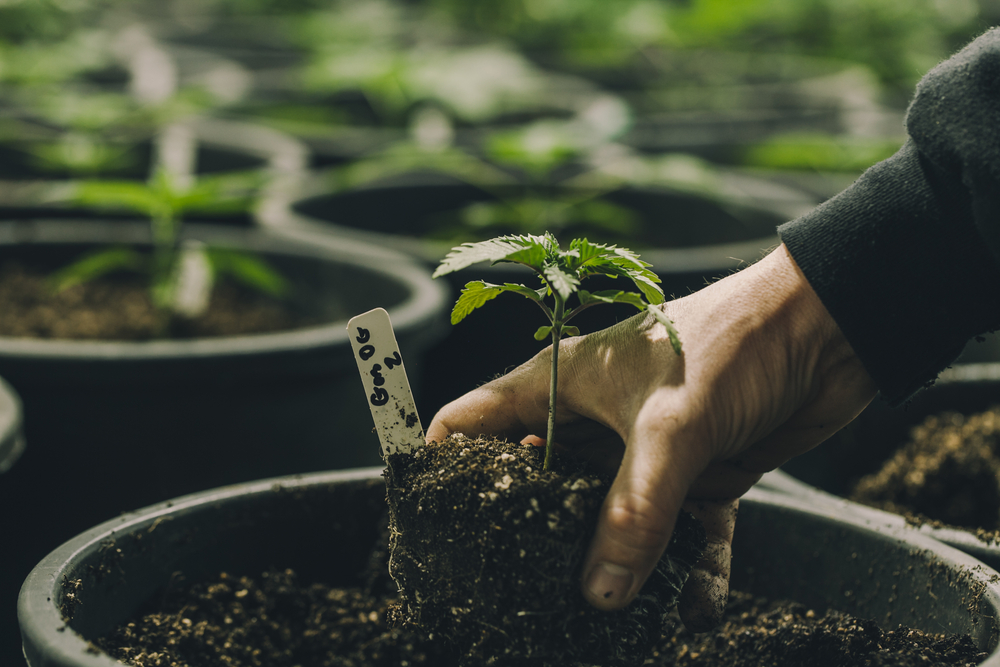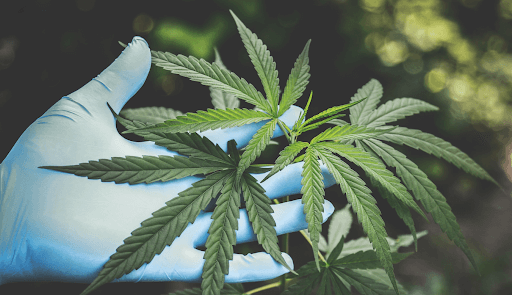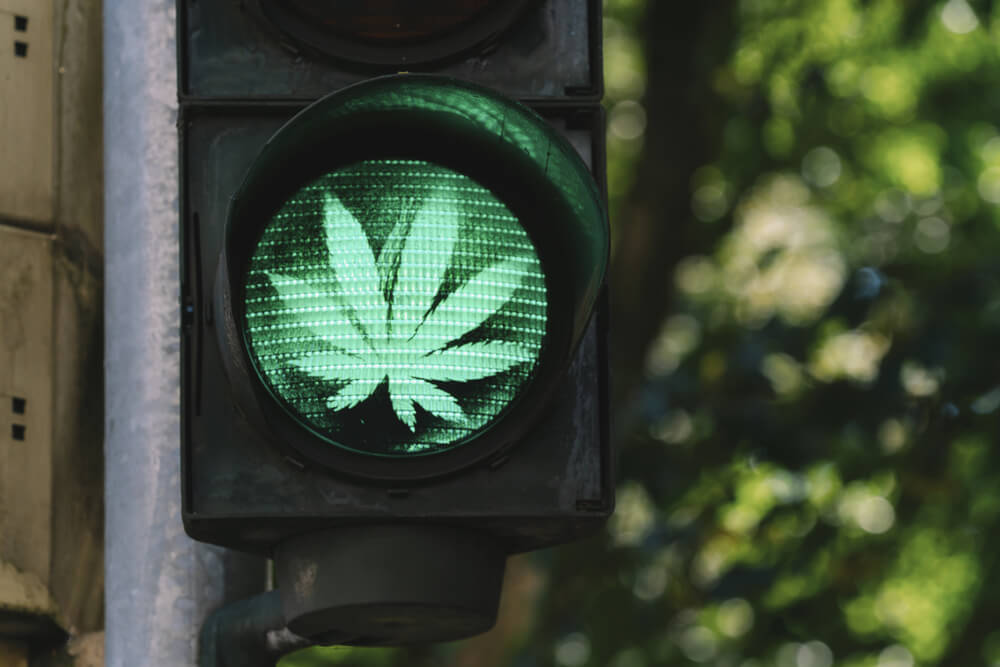Member Blog: In 2022, U.S. Cannabis Supply Exceeds 48.8 Million Pounds

by Beau Whitney, Whitney Economics
When it comes to the national and state cannabis markets, most of the conversation is centered around demand. Cannabis investors have for years raised funding based on the potential of the market, or on the growth in demand. Cannabis business operators have talked about capturing market share and, of course, policymakers have always talked about taxes. Until recently, very little data was available on cannabis supply. On December 1, my team at Whitney Economics published a report on the total cannabis supply in the U.S. market. We wanted to share some of our data and insights with the NCIA community.
The Supply and Demand of American Cannabis
The total cultivated output of cannabis in the United States in 2022 is 48.8 million pounds. This figure may be surprisingly large to some people, because it includes both legal and illicit cannabis supply, and addresses all delivery methods, including flower, edibles, concentrates, and other products. Current legal sales of cannabis will be an estimated $29.3 billion in 2022, and are projected to be at $81.6 billion by 2030.
Interesting Fact about Cannabis Demand: Unless there is some major development in cannabis application or market conditions, the total demand for cannabis will not grow substantially over the next decade. Instead, demand will shift from the illicit market to legal channels for cannabis. There will be more legal supply than illicit cannabis supply in the U.S. by 2026 or 2027. While the total number of consumers will be rather consistent, the value of the cannabis market (in terms of dollars) is actually forecasted to decline over time as more and more states come online and competition from both inside and outside of the U.S. drives down prices.
Consumer Consumption is Consistent and Predictable
The U.S. cannabis market is as big as it seems, with one out of three adults over the age of 18 consuming cannabis at least once in the past year. That number currently equates to more than 80 million adults. The report also includes data on total consumption, which is extremely consistent from state market to state market. Consumption is the basis for the amount of supply in a market.
Interesting Fact about Consumer Participation: When it comes to purchasing cannabis products, consumers remain very price sensitive. That is to say that the “elasticity of demand” is very high. This elasticity number can be used to predict legal consumer participation levels, based on how much higher the legal price is than the illicit price. Predicting consumer conversions into the legal market is not that difficult to do.
Consumer participation in the legal cannabis markets is very predictable and based on three factors:
- Price of legal cannabis relative to the illicit cannabis market
- Availability of legal cannabis supply
- Ease of access to legal cannabis
These three factors are interrelated. For example, if supply or access is limited, prices will rise and there will be less legal participation. Or if policy makers tax cannabis too much, the rate of legal conversion will slow significantly and policies surrounding public safety will be impacted. There is a sweet spot, however.
There Can Also Be Too Much Supply
On the other hand, if there is too much supply, this can be harmful to cannabis businesses as it creates a pricing race to the bottom. When businesses compete on price, profit margins are compressed, and businesses fail. States including Oregon and Michigan are currently in that situation, as prices have collapsed and some licensees are calling for cannabis business licenses to be limited.
State-by-State Cannabis Cultivation Capacity
In the 2022 U.S. Cannabis Supply Report, we were able to calculate the total legal cultivation capacity of every state in the country. California leads the nation in cultivated output at 22.2 million pounds this year alone. Using this valuable information, investors, operators, regulators, and other stakeholders in the U.S. cannabis industry can see which state markets are oversaturated by supply.
Interesting Fact about Cannabis Cultivation: Today, the total legal cultivation capacity that has already been licensed is greater than the total U.S. demand (illicit + legal) for cannabis. With more and more states coming online, this imbalance will only get more pronounced. Business operators in the cannabis industry should ready themselves for a reckoning when it comes to their profit expectations.
New Analytical Tools Have Been Developed That Combine Supply and Demand
The development of an integrated supply and demand model that encompasses both the legal and illicit markets for cannabis in the United States is a significant development for the cannabis industry. Stakeholders in every state now have the capability of assessing the market for operational, investment, and regulatory risks with granularity. Policymakers at the state and community levels can incorporate both these supply and demand models in order to make informed, data-driven decisions. There is a lot of potential in these new tools, and we are just beginning to scratch the surface of bringing a higher degree of sophistication and analysis to the cannabis industry.
 Beau Whitney is the founder and Chief Economist at Whitney Economics, a global leader in cannabis and hemp business consulting and economic research, and has served as Senior Economist for NCIA.
Beau Whitney is the founder and Chief Economist at Whitney Economics, a global leader in cannabis and hemp business consulting and economic research, and has served as Senior Economist for NCIA.
Serving an international clientele, Beau is considered one of the leading cannabis economists in the U.S. and globally. His applications of economic principles to create actionable operational and policy recommendations has been recognized by governments, and throughout the economic, investment, business communities.
Drawing upon his previous hi-tech experience, Beau has applied his supply chain and operations expertise to the cannabis industry, where he has designed and implemented efficiencies into the cultivation, extraction, edible manufacturing, wholesale and retail distribution operations of a vertically integrated cannabis operation, that eventually went public in 2015.
His Whitney Economics and New Frontier Data white papers analyzing the adult-use, medical and industrial cannabis markets have been referenced in Bloomberg, the Wall Street Journal, Washington Post, New York Times, USA Today, the Associated Press, as well as in leading cannabis industry publications. Whitney is a member of the American Economic Association, the Oregon chapter president of the National Association of Business Economics, is a member of multiple regulatory advisory committees throughout the U.S. and participates on the Oregon Governor’s Council of Economic Advisors.
Beau has provided policy recommendations at the state, national and international levels and is considered an authority on cannabis economics and the supply chain.
Member Blog: Hard to Get – Why Disposable Gloves are Scarce and Pricey

by Steve Ardagh, founder and CEO of Eagle Protect
Disposable gloves are standard issue for the medical, food, and yes – cannabis industry. But thanks to COVID and subsequent disruptions in the supply chain, the market for procuring disposable gloves has gone from routine to challenging. In fact, the demand for quality disposable gloves has skyrocketed, more than doubling since the global pandemic’s arrival, thereby creating an unpredictable cycle of availability. Demand for single-use gloves is expected to continue increasing in the coming years, as the health and safety of workforces across multiple industries – including medical, food, and cannabis-related operations – are required and dependent upon their usage.
Let’s examine the factors that have made disposable gloves both scarce… and pricey, as of late.
Global Glove Origination
Approximately 99% of all disposable gloves are manufactured in southeast Asia, most notably Malaysia and Thailand. But for these regions, compared to the U.S., lockdown to prevent the spread of COVID infections has a much more literal meaning. The restricted movement, as well as outbreaks, led to output at 60% of its normal capacity. In addition, most experts agree that there’s clearly a shortage of workers – many of whom were immigrants affected by travel restrictions. It’s estimated that an additional 25,000 workers are needed to restore full production capacity.
Supply and Demand
As the demand for disposable gloves increased globally, it put added stress on manufacturers and the supply of raw materials, driving up prices tenfold compared to pre-COVID levels. Though glove costs have recently dropped, prices have not reached pre-COVID levels.
Cost of Gas
The raw materials of nitrile gloves are primarily petrochemical based, subject to the volatile price swings in the oil and gas industry. Combined with the tenfold increase in shipping costs, disposable glove prices are not likely to continue dropping.
Labor Violations
In the midst of this price spike, one of the top importers, Malaysia’s Top Glove, the world’s largest glove producer, was banned from importing gloves to the U.S. from July 2020 to September 2021, due to conclusive evidence of forced labor. However, this ban did not extend to other countries.
Knockoffs
When the pandemic nearly doubled the demand for disposable gloves and other PPE components, several new manufacturers with little to no industry experience, assisted by dealers with nothing more than a financial incentive, flooded the market with cheap, counterfeit, and reject-quality gloves. Spotting these unscrupulous suppliers can be done by looking for a few common signs, as they’re often given away by their offering of discount or wholesale pricing, especially in bulk. It’s estimated that the market has already absorbed an influx of gloves of a defective and dangerous quality.
Safeguarding Your Operation
Currently, poor quality gloves continue to flood the disposable-use market. In business, it’s human nature to seek the lowest price for inventory, but saving a little now may cost you dearly on the backend. Cost is obviously important, but consistent quality will keep you from having to replace gloves that rip and tear too easily. When sourcing disposable gloves, seek reputable suppliers – those who have a clear ownership origin, quality web presence and active social media accounts. Taking it a step further, you can inquire about factory audits and HACCP compliance certifications. The cannabis industry has already dealt with at least one recall due to glove contamination. And recalls can have negative financial and brand ramifications. Lastly, always remember when dealing with a new vendor – you can conduct your own product trial before ordering.
 Steve Ardagh, “The Glove Guy,” is the founder and CEO of Eagle Protect, a disposable glove supplier dedicated to the responsible sourcing of quality products that ensure customer safety and impact reduction, ultimately mitigating customers’ risk. Eagle Protect is the only global PPE supplier that is a Certified B Corporation, a designation that a business has met the highest standards of verified performance, accountability, and transparency. He can be reached at steve@eagleprotect.com.
Steve Ardagh, “The Glove Guy,” is the founder and CEO of Eagle Protect, a disposable glove supplier dedicated to the responsible sourcing of quality products that ensure customer safety and impact reduction, ultimately mitigating customers’ risk. Eagle Protect is the only global PPE supplier that is a Certified B Corporation, a designation that a business has met the highest standards of verified performance, accountability, and transparency. He can be reached at steve@eagleprotect.com.
Committee Blog: Interstate Commerce – Breaking the Laws of Economics (Part 3)

By Gabe Cross and Gary Seelhorst
Members of NCIA’s State Regulations Committee
Legal cannabis, for all of its promise, has failed – in some markets spectacularly – to live up to its economic potential. But while each self-contained state market faces its own combination of political and regulatory challenges, the core of the problem everywhere is basic economics. Legal markets exist to efficiently move goods from where they are best produced to where there is the greatest demand. But cannabis, straddling the line between emerging state regulation and the remnants of federal prohibition, has negotiated that legal chasm by violating the inviolable laws of supply and demand, with predictably disappointing results. Perhaps now, in the face of a disastrous recession, with legal and legalizing states in desperate need for jobs and economic stimulus, is the time to get it right by allowing licensed commerce between legal markets.
The inability to move cannabis across state lines creates myriad problems for legal cannabis market operators that have far-ranging effects for all stakeholders in the cannabis industry, from investors to employees down to the patients and consumers who use the end products. The hindrance to economic activity also slows economic growth, employment, and tax revenues to states that have legal cannabis sales.
Oversupply Vs. Undersupply
Oversupply of cannabis in states like Oregon, which has excellent growing conditions and a favorable regulatory environment, are completely artificial and created not by the true excess of cannabis, but by the current inability to export to more populous states. This oversupply causes prices to plummet, which benefits consumers in the short term but is disastrous for small and medium-sized businesses and has far-reaching impacts on the communities that rely on this agricultural cash crop. Long term, the effect of these artificially low prices is that small businesses fail and large businesses take their assets to scale, which reduces employment and revenues in the communities that produce cannabis and extract the profits for investors in the large firms. This reduces competition and diversity in the industry, which hurts the same consumers in the long run who briefly benefited from the low prices. This is not a theoretical or academic argument, as we have seen these exact dynamics play out in Oregon over the past three years, with a staggering failure rate and rapid consolidation across the industry. Hundreds of millions of dollars of local capital have been eradicated as small businesses funded by friends and family have been forced to sell out to larger operators just to cover the worst of their debts.
In states which experience undersupply of cannabis, whether due to poor growing conditions or unfavorable regulations (or both) prices rise, hurting legal customers and patients of state-legal operators right away. Businesses can ultimately suffer losses of potential revenue, even as prices climb when consumers turn to cheaper cannabis from the illicit market. This undermines the legal systems set up by these states and pushes consumers to less-safe, unregulated products. As consumers drift from the legal to the illicit market, again the small and medium-sized businesses that currently represent the majority of the industry become financially unsustainable will suffer most, with the same end result to cannabis stakeholders as an oversupplied market.
Meanwhile, the artificial boundaries make scaling a business nearly impossible without access to an unlimited pool of capital. If a company from Washington, for example, wished to scale up and access new markets, they would have to completely recreate their entire supply chain, and most of their administrative operations, equally increasing their overhead with physical space and labor, for each new state that they wanted to enter. Effectively, they would have to create a brand-new small business in each state instead of scaling their operations efficiently and just expanding sales efforts to new territories. This is complicated in the extreme, both logistically and financially. What is worse, those redundant operations will become completely obsolete when cannabis is de-scheduled and interstate commerce allowed. This will almost certainly lead to a mass lay-off in the cannabis industry for all multi-state operators seeking to consolidate their operations. This will improve their cost competitiveness and further accelerate price drops that particularly hurt small businesses and stakeholders across the industry.
In fact, the extreme difference between the current state of the industry and a future in which interstate trade is allowed creates perverse incentives to investment, as opportunities that may be attractive in the short-term will ultimately prove disastrous long term. For example, massive energy and water-intensive indoor growing operations would be needed for New York to supply its population locally, and those facilities would require billions in investment dollars. These investments would look fantastic if one could be assured that the current regulatory environment would not change. But, if de-scheduling or other federal action allows for interstate trade, these facilities would have only a few years to reap the benefits of high margins before having to compete on cost with cannabis grown outdoors in the fertile Emerald Triangle of Northern California and Southern Oregon, which can produce much larger quantities of high-quality cannabis with a fraction of the inputs.
Newly legal net consumption states like New York and New Jersey will struggle to match supply to demand for years after initial legalization, resulting in millions of dollars of lost revenue, lost employment opportunity, and lost tax collections as the state struggles to develop the capacity to meet demand in a place that has no history of large scale production. If states that have historically been net importers plan for interstate trade from the outset, they can have a thriving retail industry with fully stocked shelves by taking high-quality products from producer states like California, Oregon, and Colorado within months of being able to import. The rapid change from essentially no legal industry to a robust, rich, and diverse retail environment would provide immediate economic stimulus in the form of jobs, thriving small businesses, and tax revenues. If new states are forced to rely solely on cannabis that is grown, harvested, processed, and distributed within state lines, it could take many years to develop the full economic benefits that a legal market could bring to bear.
All of these issues can be avoided, or at least mitigated, by a shrewd approach to incremental interstate trade instead of an instantaneous switch from 25 or more siloed industries to one national, or potentially international, market. The dynamics of how different state regulations interact can be tested and worked out thoughtfully, allowing for a more seamless transition and a clear roadmap for federal regulation when cannabis is de-scheduled. Successful interstate trade on any scale, between even just two states, will clearly signal to investors that the future of interstate trade is of pressing urgency to incorporate into their investment strategy. An investor in New York could then focus on opportunities related to local product development with the promise that affordable raw materials would be available from California and skip investing in indoor agriculture. Consumers and patients in states that allow for trade across their borders will instantly have access to a wider array of products, and as the size of the market that the industry has access to increases the dramatic supply and demand swings will be dampened by a larger and more diverse base of both consumers and producers.
Ultimately, the purpose of markets is to maximize the efficiency and utility of the flow of goods. They should move from the places where they are cheapest to produce to the places where the demand is highest. This is most effective with commodities and consumer goods, like cannabis. The current restrictions against moving cannabis across state lines completely hobble the market’s ability to perform this critical function. The result is bad for producers, consumers, regulators, and state governments. Interstate commerce for cannabis means better markets for producers, more choice for consumers, and a massive economic stimulus for all participating states in the form of job creation and increased tax revenues.
 Gabriel Cross is a Founder and CEO at Odyssey Distribution, LLC, a distributor for locally-owned craft cannabis producers and processors in Oregon. Gabe worked in the sustainable building industry for a decade before starting Odyssey and brings his experience with sustainability and systems thinking to his work in the cannabis industry. Odyssey manages logistics, sales and marketing for boutique producers so they can focus on creating great craft cannabis products for the Oregon market.
Gabriel Cross is a Founder and CEO at Odyssey Distribution, LLC, a distributor for locally-owned craft cannabis producers and processors in Oregon. Gabe worked in the sustainable building industry for a decade before starting Odyssey and brings his experience with sustainability and systems thinking to his work in the cannabis industry. Odyssey manages logistics, sales and marketing for boutique producers so they can focus on creating great craft cannabis products for the Oregon market.
 Gary Seelhorst of Flora California has a passion for developing high-quality cannabis products so their most therapeutic effects can be realized. His 25 years in pharmaceuticals and medical devices helps him bring scientific rigor to the cannabis industry. Gary is very active at both the State and Federal level as an advocate for policy reform/higher quality standards. He enjoyed lengthy stints at Eli Lilly and Pfizer (in clinical development and corporate development) and worked with several start-ups developing corporate and compliance strategies. Gary has a B.S./B.A. from UC San Diego in Biochemistry/Psychology, an M.S. in Clinical Physiology from Indiana University, and an MBA from the University of Michigan.
Gary Seelhorst of Flora California has a passion for developing high-quality cannabis products so their most therapeutic effects can be realized. His 25 years in pharmaceuticals and medical devices helps him bring scientific rigor to the cannabis industry. Gary is very active at both the State and Federal level as an advocate for policy reform/higher quality standards. He enjoyed lengthy stints at Eli Lilly and Pfizer (in clinical development and corporate development) and worked with several start-ups developing corporate and compliance strategies. Gary has a B.S./B.A. from UC San Diego in Biochemistry/Psychology, an M.S. in Clinical Physiology from Indiana University, and an MBA from the University of Michigan.

 Beau Whitney is the founder and Chief Economist at Whitney Economics, a global leader in cannabis and hemp business consulting and economic research, and has served as Senior Economist for NCIA.
Beau Whitney is the founder and Chief Economist at Whitney Economics, a global leader in cannabis and hemp business consulting and economic research, and has served as Senior Economist for NCIA.

 Steve Ardagh, “The Glove Guy,” is the founder and CEO of
Steve Ardagh, “The Glove Guy,” is the founder and CEO of 
 Gabriel Cross is a Founder and CEO at
Gabriel Cross is a Founder and CEO at  Gary Seelhorst
Gary Seelhorst